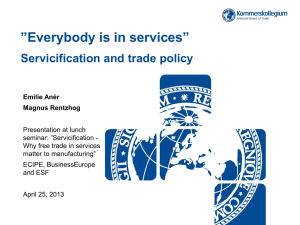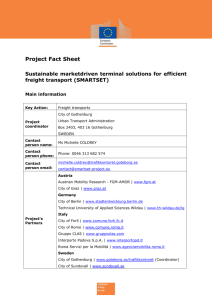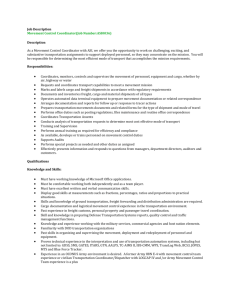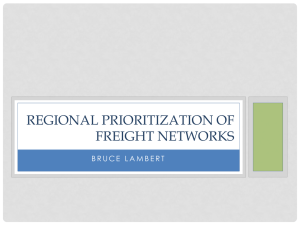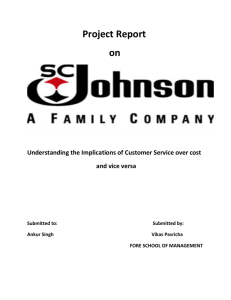Tour-based and Supply Chain Modeling for Freight: An Integrated
advertisement
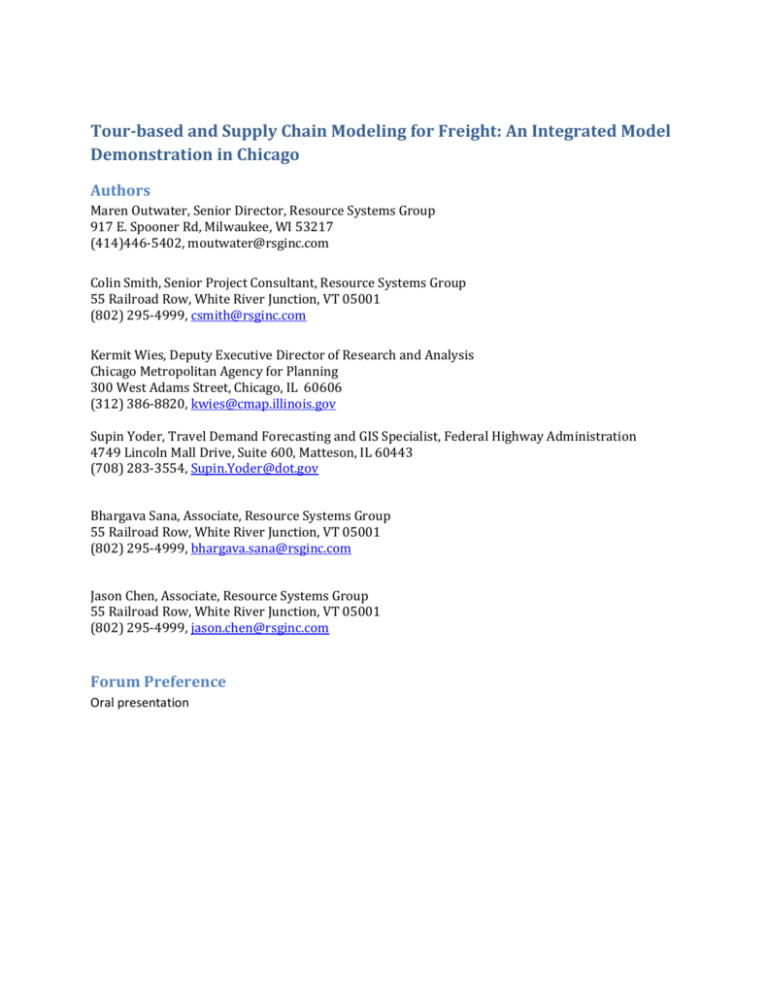
Tour-based and Supply Chain Modeling for Freight: An Integrated Model Demonstration in Chicago Authors Maren Outwater, Senior Director, Resource Systems Group 917 E. Spooner Rd, Milwaukee, WI 53217 (414)446-5402, moutwater@rsginc.com Colin Smith, Senior Project Consultant, Resource Systems Group 55 Railroad Row, White River Junction, VT 05001 (802) 295-4999, csmith@rsginc.com Kermit Wies, Deputy Executive Director of Research and Analysis Chicago Metropolitan Agency for Planning 300 West Adams Street, Chicago, IL 60606 (312) 386-8820, kwies@cmap.illinois.gov Supin Yoder, Travel Demand Forecasting and GIS Specialist, Federal Highway Administration 4749 Lincoln Mall Drive, Suite 600, Matteson, IL 60443 (708) 283-3554, Supin.Yoder@dot.gov Bhargava Sana, Associate, Resource Systems Group 55 Railroad Row, White River Junction, VT 05001 (802) 295-4999, bhargava.sana@rsginc.com Jason Chen, Associate, Resource Systems Group 55 Railroad Row, White River Junction, VT 05001 (802) 295-4999, jason.chen@rsginc.com Forum Preference Oral presentation Tour-based and Supply Chain Modeling for Freight: An Integrated Model Demonstration in Chicago Abstract Despite recent advances in freight and commercial vehicle modeling, the current state-of-thepractice methods are not adequate to address the increasingly complex issues related to freight demand. Current models are mostly based on methods that were developed for personal passenger travel and are not adequate for freight forecasting. The project includes research that has combined tour-based truck models and logistics supply chain models for urban commercial vehicle movements and that has demonstrated a functional model framework that has the potential to address the limitations of current freight demand forecasting models. The research was performed by Resource Systems Group Inc. (RSG), in partnership with the Chicago Metropolitan Agency for Planning (CMAP) and the University of Illinois at Chicago (UIC). The project introduced a model framework and focused on the estimation of each of the model components (discrete choice models estimated using existing data sources from several urban areas in North America), described the approach to linking the models together in the model application, and presented initial results from applying the model in the Chicago region. The models were estimated for demonstration purposes from several sources, since there were no datasets that could support all aspects of the new framework. To make the demonstration more practical, two commodities were chosen to model from the data available (food products and manufactured products). The models developed for the project were applied using software developed in R, open source platform which is freely available from the Comprehensive R Archive Network. Objectives Resource Systems Group Inc. (RSG), in partnership with the Chicago Metropolitan Agency for Planning (CMAP) and the University of Illinois at Chicago (UIC) developed a tour-based and logistics supply chain model for the Chicago metropolitan area as part of the Federal Highway Administration (FHWA) Broad Agency Announcement program. This work was a proof of concept study that was envisioned to be sensitive to critical global, regional and facility-based conditions. It was designed to test a new modeling framework and confirm its practicality and usefulness before conducting data collection activities to support the models. Once the models were tested, we developed recommendations for a new data collection program to support this system. Methodology We built a prototype model and proved that the concept was practical, useful, and improves upon the existing methods of modeling freight in an urban area. The focus of the project was focused on the structure of the modeling system and the ability to overcome previous limitations in freight forecasting models and did not include calibration and validation of the system for local conditions. The freight forecasting framework we developed has two main parts, which are linked to track shipments from the producer to the consumer: a national part which focuses on applying supply chain methods and a regional part which focuses on tour-based methods. This framework is presented in Figure 1. Supply Chain Methods at a National Scale The national scale portion of the freight forecasting framework focuses on how firms who buy goods select suppliers and how suppliers ship goods to their buyers. Initially, firms are synthesized across the U.S. by industry and size category. Then firms that buy goods (buyers) select suppliers to provide these goods and the demand for freight provided by the Freight Analysis Framework Version 3 (FAF3) data developed by the U.S. Department of Transportation is allocated to these buyer-supplier pairs. This process is based on shipments of goods for a particular industry. These two model components were adapted from research conducted by UIC for the Freight Activity Microsimulation Estimator (FAME)1. 1 Samimi, A., Mohammadian, A., Kawamura, K., (2009) Behavioral Freight Movement Modeling, Resource Paper W2: Behavioral Paradigms for Modeling Freight Travel Decision-Making, the 12th International Conference on Travel Behavior Research, Jaipur, India. Figure 1. Freight Forecasting Framework County Business Patterns (1) Firm Synthesis (2) Supply Chain, (3) Goods Demand, and (4) Business Locations Firms by Industry Type and Emp Size By County Macroeconomic I/O Tables Annual Commodity Flow Data for US Shipments for each BuyerSupplier Pair (5) Distribution Channels Shipments by Distribution Channel (4) National (6) Shipment Size and Frequency Networks (Line-haul distance, Access, Egress, Cost, Mode, Transfer Facilities) Truck Flows (7) Mode and Intermediate Transfers Rail Flows Water Flows Air Flows (8) Vehicle/ Tour Pattern Choice (9) Number of Tours and Stops Regional (10) Stop Sequence and Duration Empty Trucks (11) Delivery Time of Day Truck Trip Tables by Type, TOD The next step of the process is to determine the complexity of the distribution channel used in the supply chain. This concept was pioneered by Wisetjindawat, Sano, Matsumoto, and Raothanachonkum2 where 8 distribution channels comprised of combinations of raw material suppliers, producers, wholesalers, retailers, and end users were used to determine supply chains. Multinomial logit choice models were used to determine the supply chain based on buyer-supplier pair characteristics and characteristics of the industry. The models were based on large surveys conducted in Tokyo over several decades, but these data were not available for testing in this research. Data collected for a national survey as part of the FAME project was used to identify 4 distribution channels comprised of combinations of intermodal terminals, warehouses, consolidation centers, and distribution centers (direct shipments, 1 type of intermediate stop, 2 types of intermediate stops, or 3+ types of intermediate stops). This is not an ideal representation of distribution channels since it does identify all aspects of the supply chain or include all combinations of the types of intermediate stops individually, but the FAME data was a small sample and this was the best representation possible with these data. The 4 distribution channels chosen represent a complexity of supply chains rather than a specific type of supply chain. The last part of the national scale models identifies the mode and path selection based on travel time, cost, characteristics of the shipments, and characteristics of the distribution channel. This model was adapted by research conducted by de Jong and Ben-Akiva3 to predict the mode and path of long-haul movements of freight in Norway and Sweden based on a comprehensive accounting of transport and logistics costs. These include transport and intermediate handling costs, inventory costs, deterioration and damage costs, pipeline costs, and ordering and stockout costs. The application of this model in the context of our framework is to adjust parameters and constants for each distribution channel, to represent the differences that are occurring in the complexity of the supply chains. The output of the national models is freight shipments by mode and path for origins and destinations across the U.S. Tour-based Methods at a Regional Scale The tour-based models are implemented at a regional scale for truck modes only to determine individual vehicle movements needed to distribute the goods within the region. Initially, the origins and destinations of the national freight shipments are identified as internal or external movements to the Chicago region for input to the regional scale models. Shipments involving an intermodal handling facility, warehouse or distribution center were allocated to a specific facility within the Chicago region and this represented a home base for vehicle tours. The tour-based models were estimated using commercial vehicle surveys conducted in 5 urban areas in Texas and processed for tour-based analysis at UIC4. There were four modeling components in the tour-based models and several are joint estimations for two key decisions: Shipment size and frequency – This identifies the relative size of a shipment (small, medium, large) and the annual frequency of shipments needed to supply the buyer with goods over the course of a year. We had hoped to estimate these simultaneously, but the data were limited to the deliver frequencies in the survey were reported to all buyers, rather than a single buyer. So, 2 Wisetjindawat, W., Sano, K., Matsumoto, S., Raothanachonkum, P., (2007) Microsimulation Model for Modeling Freight Agents Interactions in Urban Freight Movement, prepared for the 86th Annual Meeting of the Transportation Research Board, paper number 07-2224, Washington DC. 3 de Jong, G., Ben-Akiva, M. (2007) A Micro-simulation Model of Shipment Size and Transport Chain Choice, Transportation Research Part B 41 (2007) 950–965. 4 Ruan, M., J. Lin, K. Kawamura (2011) Modeling Commercial Vehicle Daily Tour Chaining, presented at the 90th Transportation Research Board Annual Meeting, National Research Council, Washington, D.C., January 2011. we estimate the shipment weight first (as a distribution of weights in each category) and then calculate the frequency as a function of the annual tonnage and the shipment weight. Tour day patterns and vehicle choice – Tour day patterns are defined as single or multiple tours per day and direct or multi-stop tour patterns for each tour. The size of the vehicle (small, medium, large) is determined jointly with tour pattern (direct or multi-stop) because certain vehicles support different types of tours. Once the tour pattern is determined, then the number of tours per day is selected (up to 4). Stops – If the tour has multiple stops, the number of stops is determined. Cluster analysis is then used to group stops into tours. Once the tour pattern and number of stops is determined, this model identifies the duration of each stop to construct the tour to and from the home base or origin. Time of day – This model dissects each tour into trips and determines the start time of the tour, as well as the start time of each trip to allocate trips into time periods of the day for traffic assignment purposes. If a truck makes a trip outside of a reasonable time frame (after 10pm), given the tour patterns and stops required, then another truck is added to share the load. The tour-based models process shipments from the national scale models and convert these to trucks or vehicles in the second step of the process. The vehicle tours are converted to trips in the last step. Demonstration in Chicago The models developed in this project were estimated for demonstration purposes from several sources, since there were no datasets that could support all aspects of the new framework. To make the demonstration more practical, 2 commodities were chosen to model from the data available (food products and manufactured products). These were chosen to represent different aspects of goods movement and because they were the largest samples in the datasets. The models developed for the project were applied using software developed in R, open source software which is freely available from the Comprehensive R Archive Network5. Some of the national model components were implemented by CMAP as part of another project (firm synthesis, supplier selection and demand, mode and path choice) in SAS6 and converted for use in this demonstration. The other model components were developed for this project and integrated with the Chicago datasets for demonstration. The application includes all freight movements, but the models were estimated from data for food and manufactured products only. The models were not calibrated or validated for the Chicago region as it was only designed to show how these models would function in the broader regional context. Data collected in the future could support models estimated for all commodities. This framework is focused on commercial vehicle movements of urban freight and do not represent commercial service vehicles or commercial vehicles moving people (like taxis, rental cars, paratransit vehicles, shuttles, or school buses). The demonstration project was completed in April 2012 and the software and final report will be available when FHWA has completed their review. 5 http://cran.r-project.org/index.html 6 Cambridge Systematics (2011) A Working Demonstration of a Mesoscale Freight Model for the Chicago Region, Final Report and User’s Guide, prepared for the Chicago Metropolitan Agency for Planning. Expected Major Results The challenge of freight forecasting is that changes in freight traffic are often related to economic, political, geographic, and business operation factors. In addition, data sources are often proprietary and difficult to obtain. This research is designed to test a new modeling framework and confirm its practicality and usefulness before conducting data collection activities to support the models. Current forecasting methods have tried to work within existing data sources and this has limited the usefulness of the models for planning purposes. This project has produced a freight forecasting framework that incorporates supply chain methods at a national scale with tour-based methods at a regional scale to predict changes in freight movements for an urban area. As a demonstration project, the major result is the proof of the concept, the identification of data recommendations to support a model of this type in the future, and an implementation of the concept that integrates the modeling concepts with data from the Chicago region. Implications for Travel Modeling Practice Planners have and will continue to face a difficult question: Specifically, how to accommodate the growing demands of freight movement on a transportation infrastructure that is shared by the traveling public who are likewise placing more demands on the system? A modeling framework that produces accurate forecasts and can be used to test different policies and strategies related to the movement of goods is badly needed. The next generation of freight models must be able to differentiate between different alternatives and be sensitive to policies such as truck restrictions, truck only routes, impact fees and pricing, and varied land use planning/zoning strategies. This research is designed to improve the current freight forecasting models for CMAP and other MPOs around the country so they will be able to evaluate current and proposed freight alternatives and policies.

